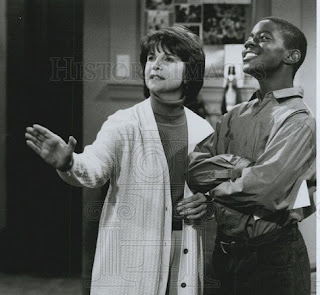I watched a few episodes of
Star Trek: The Next Generation (1987-1994) when it first aired, and now we're going through on Netflix. It has some interesting episodes, when it isn't bogged down with negotiating peace treaties between two planets where everybody looks and acts just like us.
But it is ridiculously beefcake-free. On the original series, you could count on Kirk or another crewman getting ripped out of his shirt every couple of episodes, but on
Next Generation, the cast is uniform-bound. The most you can hope for is a leisure suit cut in the middle, which they generally wear on shore leave on Risa the sex planet.
It becomes all the more frustrating when you notice the parade of hunks. Apparently the casting director had an eye for the men, and hired
Playguy-quality supermodels to play ensigns, science officers, aliens, and miscellaneous "blink and you miss them" uniform-class background players.
Here are the standouts in the episodes we've watched during the last few weeks.
Sorry, finding shirtless pics of less-well known actors from 26 years ago is not easy, so we'll have to make do with a face shot and fantasy.
1. "The First Duty" (March, 1992). Wesley Crusher and his friends cause a fatal accident at Star Fleet Academy. Robert Duncan McNeill (later Tom Paris on
Star Trek: Voyager) as Locarno, the upperclassman who is prompting him to lie about it. (Left, he takes off his shirt for some reason).
2. "The Perfect Mate" (April 1992). A woman arrives on the Enterprise who adapts perfectly to be the perfect mate of every man she encounters (every man is heterosexual, of course). So she's horny with Riker, intellectual with Picard, and a dynamo with some visiting miners. With K.C. Amos (John Amos' son) as somebody or other.
3. "I Borg" (May 1992). Jonathan Del Arco stars as a young Borg (member of a collective species), who comes aboard the Enterprise and learns to become an individual (they really like that individual thing on Trek). He likes Geordi LaForge a lot, giving the episode a gay subtext.
Jonathan Del Arco is gay in real life, and now works with GLSEN in anti-bullying initiatives.
4. "The Inner Light" (May 1992). Picard is zapped into a weird village with some ancient, some modern technology, and lives there for 30 years, while everyone tells him that his life on the Enterprise was a fantasy. Then he returns. It turns out to be a very weird way of making sure that the ancient culture is remembered. How about sending some books instead? With Patrick Stewart's son Daniel as Picard's ancient-world son, Batai.
Daniel Stewart is primarily a stage actor, but he returned to tv on an episode of
Blunt Talk, playing the son of Patrick Stewart's character again. He is not married.
5. "Time's Arrow" (June 1992). Data is zapped into the 1890s San Francisco, where out-of-phase beings are killing people to feed on their energy in the present. Um...yeah, it doesn't make any more sense when you watch it. But he gets to hang out with Mark Twain and Jack London (Michael Aron).
6. "Man of the People" (October 1992). Ship counselor Troi gets zapped with something that makes her baser instincts take over, so she tries to seduce every man on the ship, including an unnamed blond ensign (J. P. Hubbell). She also turns mean during her counseling sessions, and gets older, finally walking around in a Cruella DeVille costume.
7. "Schisms" (October 1992). Riker is having a bad day. With Scott Trost (left) as Lt. Shapely. Um...I mean Lt. Shipley.
8. "Rascals" (October 1992). The crew is zapped into the bodies of children. With David Birkin as a teenage Captain Picard.
9. "Relics" (October 1992). Scotty from the original series shows up and worries that he's become a useless relic. Also there's a Dyson Sphere, and a cute bartender (Ernie Mirich).
10. "The Quality of Life" (November 1992). A robot becomes sentient. With John Copage as a science officer.





















